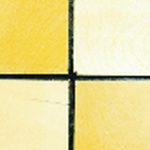
by Brian Knight—GBI Technical Advisor
Jon Staudacher, renowned boat and airplane builder, and his wife Kathy recently designed and installed a unique floor in their house in Bay City, Michigan. Their extensive collection of house pets were more than the existing carpet could take, so they decided a wooden floor would be more wear-resistant and easier to maintain. The resulting floor is easy to keep up, while maintaining the contemporary look of their house.
The floor consists of 5′ x 5′ x 3/4″ sheets of birch plywood, installed diagonally in the living area. The grain direction of each panel is alternated so the floor resembles a checker board. The top surface is varnished and the seams between the panels, which are 1/4″-wide, are filled with epoxy tinted black. They figure they will occasionally sand and re-varnish the floor to renew the finish.
Installing the floor
Prepare panels
- Sand bare wood
- Varnish several times sanding between each coat
Prepare subfloor
- Remove carpet, pad and carpet tack strip
- Set all raised nails, smooth out any other bumps
- Vacuum thoroughly to remove dirt
- Plug all holes that penetrate the subfloor to keep the epoxy from leaking through
- Snap a grid-work of chalk lines to help position panels
Apply epoxy adhesive
- Thicken epoxy with WEST SYSTEM 403 Microfibers to a mayonnaise consistency
- Apply the epoxy with a notched spreader. The depth of the notch depends on the smoothness of the subfloor.
- Spread about a 6″-wide strip of epoxy following the guidelines previously snapped on the floor.
- Distribute globs of epoxy every 6 inches over the remainder of the area to support the center of the panel.
Install the panels
- Set the panel carefully in the wet epoxy using the chalk lines to guide the location. The weight of the panel will provide adequate clamping pressure.
- Allow the epoxy to cure before walking on the panels.
Fill the seams
- Use 502 black pigment to tint the epoxy black. Be consistent with the measurements for tinting the epoxy to maintain a consistent color from batch to batch.
- Pour the tinted epoxy into the joint carefully. Remove any spills before the epoxy gels.
- Frequently check the level of epoxy in the seams. It soaks into the end grain of the plywood and if you are not careful, will leave you with a partially filled seam.
- Watch for air bubbles to rise to the top of the epoxy. Break them as necessary.






